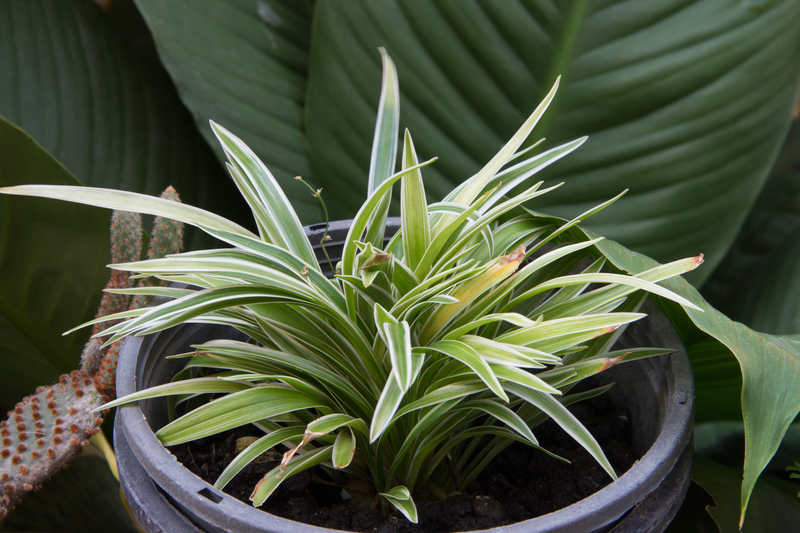Nurturing Nature: Gardens in Climate Mitigation
Posted on 27/06/2025
Climate change stands as one of the defining challenges of our era, demanding creative and effective solutions from every corner of society. Among the most accessible, beautiful, and impactful strategies is the development and nurturing of gardens. Gardens in climate mitigation represent powerful allies, offering benefits that ripple out far beyond their boundaries. In this comprehensive article, we'll explore the transformative role of gardens in climate mitigation, the science behind their effectiveness, and actionable strategies for creating climate-resilient green spaces. Whether you're a homeowner, community organizer, or policymaker, understanding how gardens nurture nature for climate resilience is crucial for our collective future.
Understanding Climate Mitigation and the Role of Gardens
Before diving into the practicalities, let's clarify key concepts:
- Climate Mitigation: Refers to actions that reduce or prevent the emission of greenhouse gases, aiming to limit the magnitude of future warming.
- Gardens: Managed green spaces, from private backyards to community plots and large urban parks, designed for aesthetics, food production, or biodiversity.
Gardens and climate mitigation are interconnected in numerous ways. Gardens act as carbon sinks, support biodiversity, improve soil health, and moderate local climates. Through careful stewardship, gardens can be intentionally designed to maximize these climate benefits.

How Gardens Contribute to Climate Mitigation
1. Carbon Sequestration: Turning Gardens into Carbon Sinks
One of the most critical functions of gardens in the fight against climate change is carbon sequestration. Plants absorb carbon dioxide (CO2) from the atmosphere during photosynthesis, storing it in their tissues and the surrounding soil. This process reduces the net greenhouse gas concentration in the atmosphere.
- Trees and Shrubs: Incorporating a diversity of trees and woody plants dramatically increases a garden's ability to capture and store carbon.
- Soil Health: Healthy, living soils rich in organic matter can sequester significant carbon. Composting, mulching, and minimizing soil disturbance enhance this effect.
- Perennials over Annuals: Perennial plants, with their deeper root systems, contribute more to soil carbon storage compared to annuals which need replanting each year.
2. Biodiversity: Gardens as Refuges
Biodiversity enhances the resilience of natural systems, making them more adaptable to climate stresses. Well-designed gardens function as microhabitats for countless species: insects, birds, pollinators, small mammals, and microorganisms--all of which play a role in climate mitigation by maintaining ecosystem functions and services.
- Native Plants: Using local species supports local wildlife and optimizes climate impacts by minimizing water and fertilizer requirements.
- Pollinator Gardens: Attract and sustain bees, butterflies, and other pollinators essential for food systems under climate stress.
- Layered Habitats: Trees, shrubs, ground covers, and water elements create a mosaic of niches, increasing overall diversity and garden health.
3. Urban Heat Island Mitigation
Urban areas tend to be significantly warmer than rural ones, a phenomenon called the "urban heat island effect." Gardens and green spaces combat this in several ways:
- Shade and Evapotranspiration: Trees and plant canopies provide shade and cool the air through natural evaporation of water.
- Temperature Regulation: Lawns, flowerbeds, and green roofs have been shown to reduce ambient air temperature, cutting energy demand for cooling.
4. Stormwater Management and Soil Protection
Climate change has increased the frequency of heavy rains and storms. Gardens can help mitigate these events by:
- Increasing Soil Absorption: Well-structured, mulched soil absorbs and holds rainwater, reducing runoff and erosion.
- Rain Gardens and Bioswales: Specially designed garden features that collect and filter stormwater, replenish groundwater, and remove pollutants.
5. Promoting Sustainable Lifestyles
Beyond their direct ecological effects, climate-friendly gardens spread awareness and inspire sustainable living:
- Local Food Production: Growing fruits and vegetables reduces food miles, packaging waste, and reliance on industrial agriculture.
- Composting: Diverts organic waste from landfills and converts it into valuable soil amendment.
- Garden Education: Gardens teach communities and children about ecology, conservation, and the importance of nature in climate mitigation.
Designing Climate-Resilient Gardens: Practical Tips
Whether you're creating a backyard retreat or a community plot, you can maximize the climate mitigation benefits of gardens by following these science-based design principles:
1. Prioritize Native and Climate-Adapted Plants
Native plants thrive in local soil and weather conditions, requiring less water, fertilizer, and maintenance. They're also more resilient to changing climates and support local wildlife better.
- Research native species suitable for your region and soil type.
- Opt for drought-tolerant varieties in water-scarce areas.
- Diversify plantings to guard against pests and diseases.
2. Enhance Soil Health
Healthy soils are the foundation of productive, resilient gardens and ecosystems. To nurture living soils:
- Add compost and organic matter regularly.
- Avoid chemical fertilizers and pesticides when possible.
- Use mulch to conserve moisture, moderate temperature, and feed the soil as it breaks down.
- Minimize digging and tilling, which releases stored carbon and disrupts soil life.
3. Plant Trees and Shrubs Strategically
Trees and shrubs are powerful carbon sinks in any garden. Plant them to:
- Shade buildings and outdoor spaces, reducing energy for cooling.
- Act as windbreaks, protecting against heat loss in the winter.
- Create habitat diversity for birds and beneficial insects.
4. Incorporate Water Management Features
Water efficiency is vital in a changing climate:
- Install rain barrels to capture and reuse rainwater.
- Construct rain gardens to filter runoff and recharge aquifers.
- Use drip irrigation to minimize water loss and target roots directly.
5. Foster Biodiversity and Edible Landscapes
Mixed-use gardens--with ornamental, edible, and native plantings--offer resilience and productivity:
- Mix vegetables, herbs, flowers, fruit shrubs, and trees for year-round yields.
- Plant flowering species for continuous pollinator support.
- Include habitat features like birdbaths, log piles, and insect hotels.
Examples of Gardens Nurturing Climate Resilience
Urban Community Gardens
In cities worldwide, community gardens have become beacons of sustainability. They transform vacant lots into productive green spaces, store carbon, manage stormwater, and foster social cohesion--all while providing fresh food and educational opportunities.
Agroforestry and Food Forests
Agroforestry systems and permaculture-inspired food forests mimic the structure of natural woodlands, combining trees, shrubs, and groundcovers. They yield food, medicine, and materials while delivering unparalleled climate mitigation through carbon sequestration and habitat creation.
School Gardens as Living Classrooms
School gardens engage students in hands-on climate action. Children learn how plants cycle nutrients, how pollinators function, and how personal actions influence the environment. These experiences foster lifelong environmental stewardship and scalable impacts as students bring these lessons home.
Green Roofs and Walls
In densely built environments, green roofs and living walls introduce nature where land space is limited. They insulate buildings, lower urban temperatures, absorb rainfall, and boost local air quality--making cities more livable and climate-resilient.
Challenges and Considerations in Climate Mitigation Gardening
While gardens hold tremendous promise in climate action, there are challenges to maximize their impact:
- Scale: Individual gardens sequester modest amounts of carbon, but their cumulative effects at the city or national level are significant.
- Maintenance: Ongoing maintenance is essential; invasive species, neglect, and overuse of synthetic chemicals can undermine climate benefits.
- Access and Equity: Ensuring underserved communities have opportunities and resources to create green spaces is vital for inclusive climate mitigation.
The Future: Gardens as Hubs of Climate Adaptation and Community Wellbeing
Gardens don't just mitigate climate change--they help societies adapt to it. Green spaces reduce temperature extremes, buffer floods, supply emergency food, and offer places of respite during heatwaves. Their mental and physical health benefits are profound, particularly in urban areas under environmental stress.
Public policy is beginning to recognize the multiple co-benefits of gardens. Municipalities are integrating green infrastructure into climate action plans, and governments worldwide are launching initiatives to promote urban forestry, pollinator habitats, and edible landscapes.

How You Can Get Involved: Steps Toward Greener, Healthier Communities
- Start at home: Transform a balcony, yard, or container into a mini carbon sink and wildlife haven.
- Join or organize community gardening projects: Advocate for green spaces in parks, schools, and vacant land.
- Support native plant nurseries and eco-friendly products: Choose sustainable sources and educate others about their benefits.
- Promote policies for green space expansion and protection: Engage with local leaders about the importance of gardens in climate strategy.
- Share your garden's story: Inspire neighbors and social networks by showing what's possible with a climate-friendly garden.
Conclusion: Nurturing Nature for a Cooler Planet
Gardens are more than just places of beauty and relaxation. They function as vital infrastructure in the global effort to address climate change, regenerate ecosystems, and build healthier, more resilient communities. As we nurture nature within our gardens, we simultaneously nurture hope for a sustainable, thriving future.
By cultivating diverse, resilient, and climate-smart gardens, each of us can play a meaningful role in climate mitigation and adaptation. Now is the time to dig in--literally--and help our world bloom into a cooler, greener, more vibrant place for generations to come.
Remember: Every garden counts in the fight against climate change.



